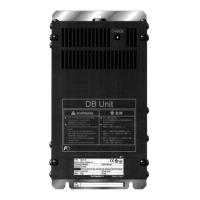5.3 Description of Function Codes
5-201
FUNCTION CODES
Chap 5
[ 3 ] PID command with UP/DOWN control (J02 = 3)
When UP/DOWN control is selected as a PID speed command, turning the terminal command “UP” or “DOWN”
ON causes the PID set point value to change within the range from minimum scale to maximum scale.
The PID set point value can be specified in physical quantity units (such as temperature or pressure) with the
minimum scale (J106) and maximum scale (J107).
To select UP/DOWN control as a PID set point value, the “UP” and “DOWN” should be assigned to the digital input
terminals [X1] to [X5]. ( Function codes E01 to E05 data = 17, 18)
“UP” “DOWN”
Action
Data = 17 Data = 18
OFF OFF Retain PID set point value.
ON OFF Increase PID set point value at a rate between 0.1%/0.1 s and 1%/0.1 s.
OFF ON Decrease PID set point value at a rate between 0.1%/0.1 s and 1%/0.1 s.
ON ON Retain PID set point value.
The inverter internally holds the PID command value set by UP/DOWN control and applies the held
value at the next restart (including powering ON).
[ 4 ] PID command via communications link (J02 = 4)
Use function code S13 to specify the PID command by communications. The transmission data of 20000 (decimal)
is equivalent to 100% (maximum set point value) of the PID command. For details of the communications format,
refer to the RS-485 Communication User’s Manual.
• Other than the remote command selection by J02, the PID multistep commands 1, 2 or 3 (specified by
J106, J137 or J138, respectively) selected by the PID multistep commands “PID-SS1” and “PID-SS2
can also be used as preset set point values for the PID command.
In dancer control (J01 = 3),
the setting command from the keypad is in conjunction with the function
code J57 (PID control: Dancer position set point), and it is saved as function code data.
Selecting Feedback Terminals
For feedback control, determine the connection terminal according to the type of the sensor output.
• If the sensor is a current output type, use the current input terminal [C1] (C1 function) of the inverter.
• If the sensor is a voltage output type, use the voltage input terminal [12] of the inverter, or switch over the
terminal [C1] (V2 function) to the voltage input terminal and use it.
For details, refer to the descriptions of E61 to E63.
<Application example: Process control> (for air conditioners, fans and pumps)
The operating range for PID process control is internally controlled as 0% through 100%. For the given feedback
input, determine the operating range to be controlled by means of gain adjustment.
Example: When the external sensor has the output range of 1 to 5 V:
• Use terminal [12] as the input terminal in voltage.
• Set the gain (C32 for analog input adjustment) to 200% in order to make 5V of the maximum output of the
external sensor to be 100% of input scale.
For the input specification of terminal 12, 0-10V is equivalent to 0-100%.Therefore the gain has to be set 200%
(= 10 V / 5 V *100). Note also that any bias setting does not apply to feedback control.

